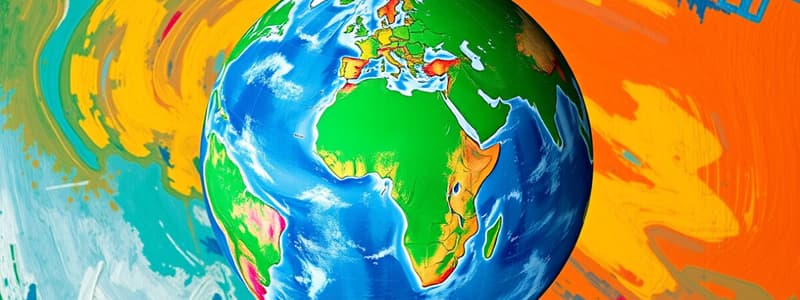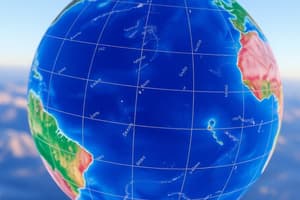Podcast
Questions and Answers
What is the main reason for the different climatic zones on Earth?
What is the main reason for the different climatic zones on Earth?
- The angle at which sunlight hits the surface (correct)
- Variations in atmospheric pressure
- The distance to the Earth's core
- The distribution of continents and oceans
How is local time established for a specific location?
How is local time established for a specific location?
- By measuring the length of shadows cast by objects
- By the position of the Sun in relation to the local latitude (correct)
- Through the use of atomic clocks
- By the altitude above sea level
What happens to time when traveling from west to east?
What happens to time when traveling from west to east?
- Time varies based on the position of the moon
- Time remains constant regardless of direction
- Time is lost due to the rotation of the Earth
- Time is gained because the Earth rotates west to east (correct)
Why do temperatures decrease as one moves away from the Equator?
Why do temperatures decrease as one moves away from the Equator?
What is the total number of degrees in longitude around the Earth?
What is the total number of degrees in longitude around the Earth?
What is the primary purpose of the International Date Line?
What is the primary purpose of the International Date Line?
What factors necessitate the existence of multiple time zones in some countries?
What factors necessitate the existence of multiple time zones in some countries?
What do the terms 'ante meridiem' and 'post meridiem' refer to?
What do the terms 'ante meridiem' and 'post meridiem' refer to?
How do lines of latitude and longitude function on a map?
How do lines of latitude and longitude function on a map?
What function does a globe serve concerning the Earth?
What function does a globe serve concerning the Earth?
What imaginary line divides the Earth into the Northern and Southern Hemispheres?
What imaginary line divides the Earth into the Northern and Southern Hemispheres?
What is the significance of the Prime Meridian in geography?
What is the significance of the Prime Meridian in geography?
How many degrees of longitude are represented on a globe?
How many degrees of longitude are represented on a globe?
Which of the following best describes a globe?
Which of the following best describes a globe?
Which country is known to have multiple time zones?
Which country is known to have multiple time zones?
Flashcards are hidden until you start studying
Study Notes
Globe, Latitude, and Longitude
- A globe represents the Earth in three-dimensional form.
- The Prime Meridian separates the globe into Eastern and Western Hemispheres.
- Latitude and longitude create a coordinate grid for pinpointing locations on Earth’s surface.
- The Prime Meridian runs through the Royal Observatory in Greenwich, England.
- There are 360 degrees of longitude globally, facilitating time measurement.
Geography Concepts
- Geoid defines the Earth's shape—an irregular sphere.
- A globe accurately depicts landmasses and water bodies in proportion.
- The Equator is an imaginary line that divides the Earth into Northern and Southern Hemispheres.
- Canada is an example of a country with multiple time zones due to its vast size.
- The Torrid Zone is recognized as the hottest temperature zone on Earth.
International Date Line
- The Earth rotates around an imaginary line called the axis.
- Latitudes measure north or south distance from the Equator; important for navigation.
- Longitudes extend vertically from the North Pole to the South Pole, facilitating east-west measurements.
- Latitude and longitude lines intersect to create a grid system used on maps.
Time Zones and Standard Time
- The International Date Line is where a calendar day shifts, observing a 24-hour cycle.
- Standard time balances time across various regions, minimizing confusion caused by multiple local times.
- Countries with significant east-west distance need several time zones to maintain local time precision.
- The terms ante meridiem (a.m.) and post meridiem (p.m.) stem from Latin phrases indicating times before and after noon, respectively.
Locating Places and Climate Prediction
- Maps utilize latitude and longitude for identifying specific locations, with 180 degrees of latitude and 360 degrees of longitude.
- Every degree of latitude and longitude is divided into minutes and seconds for precise navigation.
- Climate zones, determined by latitude:
- Torrid Zone (near the Equator) is generally hot.
- Temperate Zone experiences mild climates.
- Frigid Zone (near the poles) is very cold.
- Local time relies on the position of the overhead Sun, signaling noon for each respective latitude.
Effects of Earth's Movement on Time and Temperature
- Traveling west to east results in gaining time due to the Earth’s eastward rotation.
- Moving away from the Equator leads to temperature drops as the Sun’s rays hit at slanted angles, distributing heat over larger areas.
Studying That Suits You
Use AI to generate personalized quizzes and flashcards to suit your learning preferences.




